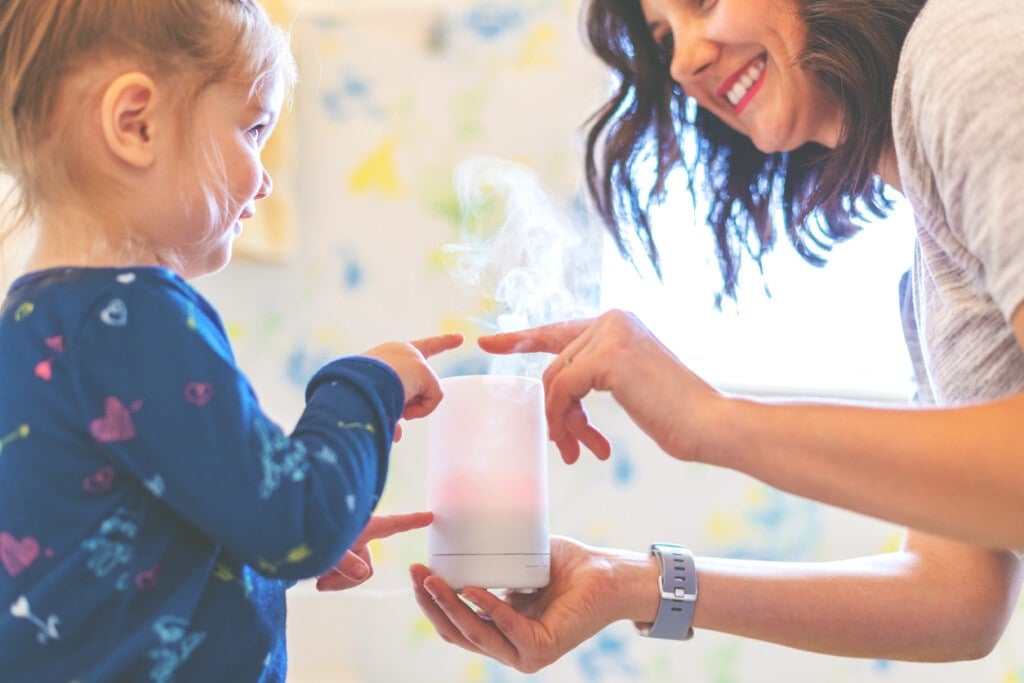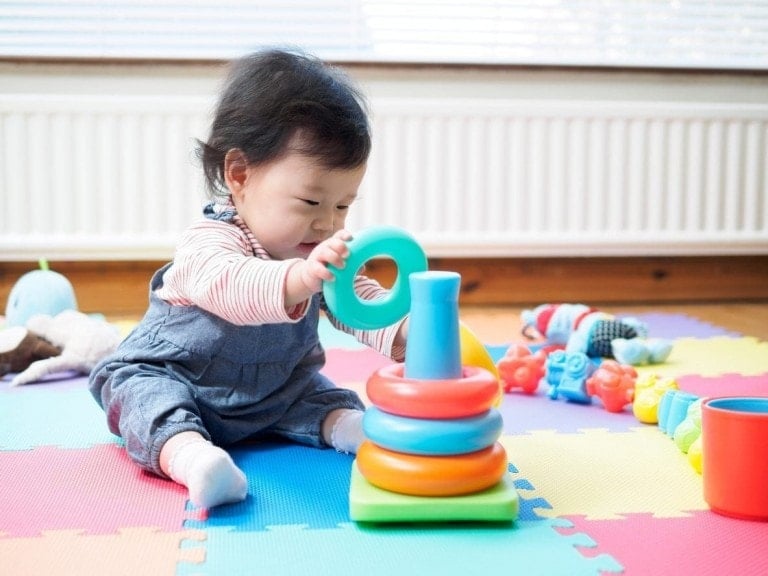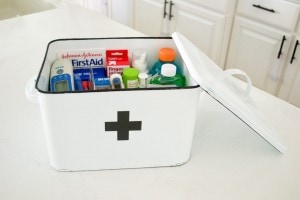My son developed his first bad cold at 10 months old. A few days in, we set up a humidifier about 3 feet from his crib. We plugged in a nonmedicated, name-brand lavender and rosemary vapor pad touting soothing, sleepy-time comfort. Within a week and a half of several sleepless nights and doctor trips, his viral infection and croup had cleared! Later, I wondered if the essential oil vapor pad was actually a safe and smart product to expose my son to and whether essential oils are okay for babies and kids.
General dissatisfaction with conventional medicine has recently led to a boom in the essential oils business.12 With more parents wanting greater control over their medicine cabinets, interest in accessing various alternative options has increased. But there’s also been some dangerous misinformation about essential oils and their use. I know now that “overexposure to aerosols with essential oils in them can irritate the lungs, eyes, and skin of young children, sensitive adults, and even pets.”4 (Cue the never-ending mom guilt.) Even the best intentions can cause more harm than good without the proper information. So, let’s explore when to use or avoid essential oils for kids and how to use them properly.
Are Essential Oils Safe for Babies and Kids?
Adults use a variety of essential oils for everything from better sleep to energizing and uplifting during an afternoon slump. However, not all essential oils are safe for children. Currently, there isn’t much medical research about essential oil safety and children.4 In fact, the American Academy of Pediatrics (AAP) says you should not let younger kids use essential oils.14
When you use essential oils appropriately, toxicity rarely happens. According to Poison Control, though, infants and children have thinner skin and less-developed livers and immune systems. This makes them more vulnerable to potential toxicity associated with oil use.1,2 It’s important to consult medical professionals to discuss potential issues or interference with medication before experimenting with essential oils. Plus, accidental ingestion, especially in young children, can lead to medical emergencies like poisoning, skin irritation, or other health issues.1,2,13
In 2018, poison control centers in the United States recorded an alarming number of kids under 12 accidentally swallowing essential oils or getting oils on their skin or in their eyes. According to an analysis by the American Association of Poison Control Centers conducted for The New York Times, there were more than 17,000 incidents that year. This was an 85% increase over the number of cases reported in 2014.3
Which Essential Oils Are Safe?
According to the Children’s Hospital of Philadelphia, choosing a pure (rather than synthetic) oil is important when using certain essential oils for young kids. You should see “the common and Latin names of the plant,” “the part of the plant used to make the oil,” “the country of origin,” and “how the oil was extracted” all on the label.4
Some medical experts suggest that parents should limit the use of aromatherapy to children older than 3.3,4 This is due to the lack of clinical research to support its use with younger children and the increased risks of adverse reactions. Some essential oils that are safe and effective for children over 3 are:4
Staying mindful of individual allergy histories, parents can select options from this group of oils.4 Additionally, essential oils should never be swallowed, ingested, or applied directly to the skin without being diluted with a carrier oil.4,5 Because essential oils are highly concentrated extracts from plants, they’re flammable, so you should never heat them.4,17
What Are the Benefits of Lavender Oil?
Lavender oil is a staple for many people because of its calming effect. You can use it to relieve anxiety and help little ones relax and prepare for sleep if they have insomnia.5 However, topical application can affect hormones in males who haven’t reached puberty. So, it’s best for young children to avoid topical usage of lavender oil.6
What Are the Benefits of Citrus Oil?
Citrus oils like mandarin, lemon, grapefruit, and bergamot are excellent options for mood-boosting, energizing, immune system support, and natural surface cleaning.18 These are a good option in a diffusing device for children older than 3 for limited periods.4 It’s important to note that parents should “avoid applying citrus oils — such as those made from grapefruit, lemon, or orange — to the skin” directly. These oils “can react with ultraviolet radiation from the sun to cause burns, rashes, or skin discoloration.”15
However, citronella and citrus oils are also insect repellents.16 The National Pesticide Information Center advises that you shouldn’t use some oil of citronella products on children under 6 months (unless a doctor directs you to).6 However, citronella can help “repel mosquitoes” and “may also be effective against kissing bugs, fleas, aphids, mites, and flies.”16 A safer option for children older than 6 months could be sporting a wearable kids’ essential oil diffuser bracelet or device.7
What Are the Benefits of Ginger Oil?
You can use ginger oil to ease nausea, digestive upset, colds, and headaches. The “warming quality of ginger oil” can help “relieve feelings of anxiety, anxiousness, depression, and exhaustion.” It can also help with sleep and may reduce inflammation.8,9
How To Properly Use Essential Oils
If you use essential oils as an adult, you know that you can apply them in various ways. The same is true for babies and kids, but you must take special care with close monitoring. According to Johns Hopkins Medicine, you should call the doctor immediately “if your child develops a skin rash or skin irritation, headaches, vomiting, coughing, wheezing, or difficulty breathing” from essential oil use.5
Depending on the issue you’re looking to remedy and your child’s age, essential oils can be inhaled, diffused, or applied to the skin. If applying it to the skin, experts agree it’s best to dilute the oil in a carrier oil to ensure safe delivery.19 A carrier oil is a vegetable or nut oil or even water.20 To create a diluted solution, add three drops of pure essential oil to 1 teaspoon of carrier oil to make a 3% solution.2,11 You can find dilution guidelines for adults and children in the “Essential Oil Safety” guide from the Tisserand Institute here.
Johns Hopkins medical experts suggest following a few other tips to safely use essential oils with your kids. Parents should “store oils in a cool, dry place away from direct sunlight and out of reach of children.” Experts also recommend a “patch test,” which involves applying oil to a little patch of your child’s skin and waiting 24 hours to assess the reaction. Lastly, talk to your doctor if you aren’t sure how to use or dilute essential oils on your child properly.5
The Bottom Line
While essential oils can relieve many issues, parents or caregivers should never use essential oils to replace expert medical care.4 Unlike government-regulated prescription drugs, essential oils haven’t undergone the intensive research required for FDA-approved medications.10
So, rather than simply buying something off the shelf at your local department store, it’s important to find a reputable company to purchase quality essential oils from. This way, you can trust what you’re using on your child. To be on the safe side, talk to your doctor about essential oil use before trying it out. Remember, their usage depends on several factors, including your child’s age, any underlying health conditions, their medication usage, the essential oil dosage, and how you choose to distribute it.











